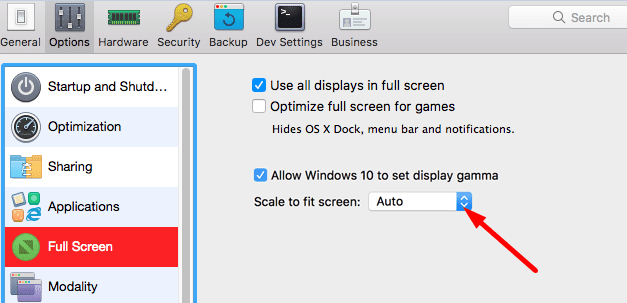

- Parallels for mac show screen on dock mac os x#
- Parallels for mac show screen on dock full#
- Parallels for mac show screen on dock series#
- Parallels for mac show screen on dock windows#
Parallels for mac show screen on dock windows#
Why would you want to do this? Imagine working in multiple Microsoft Office windows on one, full-screen Windows desktop, quickly switching over to a copy of Adobe Photoshop CS3 on the Mac, where you're editing a high-res image, and then jumping back to paste that edited image into your Word document. Combining Parallels in Full-Screen mode with Spaces means you can quickly switch between full-screen views of multiple operating systems. We'll dive more deeply into Spaces in Chapter 10, but I want to use the feature here to give you a feel for the power of running more than one operating system at a time.
Parallels for mac show screen on dock mac os x#
Mac OS X 10.5 Leopard has a new feature called Spaces, which allows you to have more than one desktop.
Parallels for mac show screen on dock full#
From the Parallels menu bar, choose View > Full Screen.To enter Full-Screen mode from Coherence mode: To enter Full-Screen mode from Single Window mode:Ĭlick the Full-Screen button on the right side of the Parallels window.įrom the Parallels menu bar, choose View > Full Screen.Ī message box appears telling you that you can use Alt + Enter to exit Full-Screen mode, or use Control + Alt to release the keyboard and mouse from Windows' control. It completely fills the screen, and is best when you're working in multiple Windows applications and don't need access to the Mac operating system. Parallels' Full-Screen view lets you work in Windows as though it is the primary operating system on your Mac. In Coherence mode: From the Parallels menu bar, choose View > Single Window.In Full-Screen mode: Press Alt-Option + Enter.If you're in one of the other modes and want to return to the Single Window view, here's what you do: The first time you launch Windows in Parallels, it displays in Single Window mode. You can also go back the other way, from Mac to Windows. If you click and hold on a document in the Parallels window and drag it onto the Mac OS X desktop, a copy will be placed there. Single Window mode also lets you easily move documents between desktops and folders in the two operating systems. You can right-click or Command-click the device icons to change aspects of the VM's virtual hardware. In this mode, you have access to the control bar on the right side of the Parallels window, as well as device icons on the window's bottom right frame. Parallels' default view is to run Windows in a window ( FIGURE 4.9).įigure 4.9 In Single Window mode, Windows runs in a window on the Mac desktop. Now, let's take a detailed look at the three faces of Parallels. And if you're working in Full-Screen mode, you'll need to switch to either Coherence mode to access the functions through the menu bar, or to Single Window mode to access the buttons. If you're working in Coherence mode, you'll need menu bar access because the control bar isn't visible in this mode. The functions assigned to each of these buttons are also duplicated in the Parallels menu bar items. Restores the VM from the most recent snapshot. Takes a snapshot of the virtual machine in its current state.

Puts the VM in Coherence mode, so Windows applications float freely on the Mac desktop. Opens the virtual machine so that it completely fills the screen. Pauses the virtual machine, similar to putting a physical computer to sleep. Stops the virtual machine and shuts down Windows. These buttons control key functions for Parallels.įigure 4.8 The Parallels control bar runs down the right side of the Parallels window.įrom the top to the bottom, here's what each control bar button does: You'll also see them when Parallels is running, but no virtual machine is active.
Parallels for mac show screen on dock series#
If you launch Parallels in Single Window mode, you'll notice a series of buttons, which Parallels calls the control bar, running down the right side of the window ( FIGURE 4.8). You won't see this interface in Full-Screen or Coherence mode. You'll be able to view and work within the Parallels interface in only two instances: when the Windows operating system is running in Single Window mode, and when you're managing and tweaking your virtual machine when it is not running. But before we get into the details, let's talk about the Parallels interface. The Windows taskbar is available for managing these programs, sitting just above the Dock.Įach view has its advantages, and you can switch between them quickly and easily. In this mode, Windows applications float freely on the Mac desktop, almost as though they are Macintosh applications. It appears as though Windows is the only operating system on your Mac. With this view, Windows fills the entire screen-there are no Mac OS X elements visible anywhere. This gives you access to two operating system desktops at the same time, making it particularly easy to drag files between them. In this mode, Windows runs within a window on the Mac desktop. Learn More Buy The Three Faces of ParallelsĪs mentioned briefly in Chapter 1, virtual machines in Parallels Desktop for Mac can be run in three ways.


 0 kommentar(er)
0 kommentar(er)
